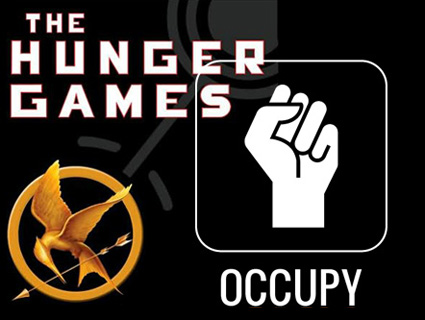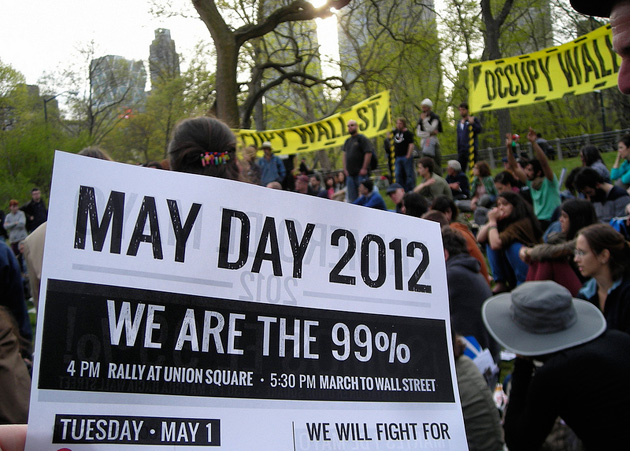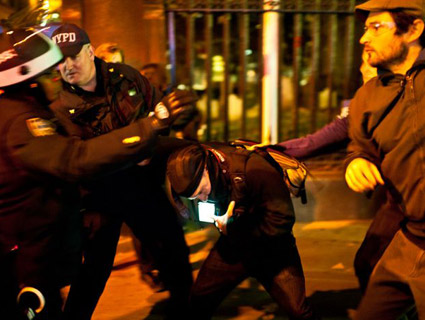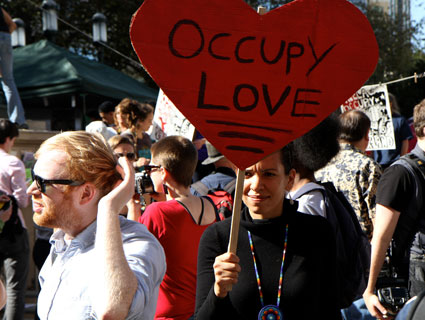
Hunger Games: <a href="http://en.wikipedia.org/wiki/File:Hunger_games.jpg">Scholastic Press</a>/Wikipedia; Fist: <a href="http://occupydesign.org/gallery/designs/occupy-fist-logo">Occupy Design</a>
This story first appeared on the TomDispatch website.
When I was growing up, I ate books for breakfast, lunch, and dinner, and since I was constantly running out of reading material, I read everyone else’s—which for a girl with older brothers meant science fiction. The books were supposed to be about the future, but they always turned out to be very much about this very moment.
Some of them—Robert Heinlein’s Stranger in a Strange Land—were comically of their time: that novel’s vision of the good life seemed to owe an awful lot to the Playboy Mansion in its prime, only with telepathy and being nice added in. Frank Herbert’s Dune had similarly sixties social mores, but its vision of an intergalactic world of disciplined desert jihadis and a great game for the substance that made all long-distance transit possible is even more relevant now. Think: drug cartels meet the oil industry in the deep desert.
We now live in a world that is wilder than a lot of science fiction from my youth. My phone is 58 times faster than IBM’s fastest mainframe computer in 1964 (calculates my older brother Steve) and more powerful than the computers on the Apollo spaceship we landed on the moon in 1969 (adds my nephew Jason). Though we never got the promised jetpacks and the Martians were a bust, we do live in a time when genetic engineers use jellyfish genes to make mammals glow in the dark and nerds in southern Nevada kill people in Pakistan and Afghanistan with unmanned drones. Anyone who time-traveled from the sixties would be astonished by our age, for its wonders and its horrors and its profound social changes. But science fiction is about the present more than the future, and we do have a new science fiction trilogy that’s perfect for this very moment.
Sacrificing the Young in the Arenas of Capital
The Hunger Games, Suzanne Collins’s bestselling young-adult novel and top-grossing blockbuster movie, is all about this very moment in so many ways. For those of you hiding out deep in the woods, it’s set in a dystopian future North America, a continent divided into downtrodden, fearful districts ruled by a decadent, luxurious oligarchy in the Capitol. Supposedly to punish the districts for an uprising 74 years ago, but really to provide Roman-style blood and circuses to intimidate and distract, the Capitol requires each district to provide two adolescent Tributes, drawn by lottery each year, to compete in the gladiatorial Hunger Games broadcast across the nation.
That these 24 youths battle each other to the death with one lone victor allowed to survive makes it like—and yet not exactly like—high school, that concentration camp for angst and competition into which we force our young. After all, even such real-life situations can be fatal: witness the gay Iowa teen who took his life only a few weeks ago after being outed and taunted by his peers, not to speak of the epidemic of other suicides by queer teens that Dan Savage’s ‘It Gets Better’ website, film, and books aspire to reduce.
But really, in this moment, the cruelty of teens to teens is far from the most atrocious thing in the land. The Hunger Games reminds us of that. Its Capitol is, of course, the land of the 1%, a sort of amalgamation of Fashion Week, Versailles, and the KGB/CIA. Collins’s timely trilogy makes it clear that the 1%, having created a system of deeply embedded cruelty, should go, something highlighted by the surly defiance of heroine Katniss Everdeen—Annie Oakley, Tank Girl, and Robin Hood all rolled into one—who refuses to be disposed of.
Now, in our world, gladiatorial entertainment and the disposability of the young are mostly separate things (except in football, boxing, hockey, and other contact sports that regularly result in brain damage, and sometimes even in death). But while the Capitol is portrayed as brutal for annually sacrificing 23 teenagers from the Districts, what about our own Capitol in the District of Columbia? It has a war or two on, if you hadn’t noticed.
In Iraq, 4,486 mostly young Americans died. If you want to count Iraqis (which you should indeed want to do), the deaths of babies, children, grandmothers, young men, and others total more than 106,000 by the most conservative count, hundreds of thousands by others. Even the lowest numbers represent enough kill to fill nearly 5,000 years of Hunger Games.
Then, of course, there are thousands more Americans who were so grievously wounded they might have died in previous conflicts, but are now surviving with severe brain damage, multiple missing limbs, or other profound mutilations. And don’t forget the trauma and mental illness that mostly goes unacknowledged and untreated or the far more devastating Iraqi version of the same. And never mind Afghanistan, with its own grim numbers and horrific consequences.
Our wartime carnage has been on a grand scale, but it hasn’t been on television in any meaningful way; it’s generally been semi-hidden by most of the American media and the government, which censored images of returning coffins, corpses, civilian casualties, and anything else uncomfortable (though in our science-fiction era when every phone is potentially a video camera, the leakage has still been colossal). Most of us did a good job of being distracted by other things—including reality TV, of course. The US Ambassador and military commander in Afghanistan were furious not that our soldiers struck jokey poses with severed limbs, but that the Los Angeles Times dared to publish them last month. And those whistleblowers who made the effort to reveal the little men behind the throne are facing severe punishment. Witness one Hunger-Games-style hero, Bradley Manning, the slight young soldier turned alleged leaker, long held in inhumane conditions and now facing a potential life sentence.
The Return of Debt Peonage
In The Hunger Games, kids in poor families take out extra chances in their District lottery—that is, extra chances to die—in return for extra food rations; in ours, poor kids enlist in the military to feed their families and maybe escape economic doom. Many are seduced by military recruiters who stalk them in high school with promises as slippery as those the slave trade uses to recruit poor young women for sex work abroad.
 And then there’s another form of debt peonage that is far more widespread in our strange and ever-changing land: student loans. The young are constantly told that only a college education can give them a decent future. Then they’re told that, to pay for it, they need to go into debt—usually into five figures, sometimes well into six. And these debts are, in turn, governed by special laws that don’t allow you to declare bankruptcy—no matter what. In other words, they are guaranteed to follow you all your life.
And then there’s another form of debt peonage that is far more widespread in our strange and ever-changing land: student loans. The young are constantly told that only a college education can give them a decent future. Then they’re told that, to pay for it, they need to go into debt—usually into five figures, sometimes well into six. And these debts are, in turn, governed by special laws that don’t allow you to declare bankruptcy—no matter what. In other words, they are guaranteed to follow you all your life.
One of my close friends wept when her husband began to earn enough money to pay off her $45,000 loan, structured so that it looked like she would continue to pay interest on it for the rest of her life; not so dissimilar, that is, from the debts sharecroppers and workers in company towns used to incur.
In other words, we’re creating a new generation of debt peonage. And my friend is not the worst case by far. Early in the Occupy Wall Street moment, she told me, someone arrived at Zuccotti Park in downtown Manhattan with markers and cardboard on which participants were to write their debt. What shocked her was how many of the occupiers in their early twenties were already carrying huge debt burdens.
According to the website for Occupy Student Debt, 36,000,000 Americans have student debts. These have increased more than fivefold since 1999, creating a debt load that’s approaching a trillion dollars, with students borrowing $96 billion more every year to pay for their educations. Two-thirds of college students find themselves in this trap nowadays. As commentator Malcolm Harris put it in N + 1 magazine:
Since 1978, the price of tuition at US colleges has increased over 900%, 650 points above inflation. To put that number in perspective, housing prices, the bubble that nearly burst the US economy, then the global one, increased only fifty points above the Consumer Price Index during those years. But… wages for college-educated workers outside of the inflated finance industry have stagnated or diminished. Unemployment has hit recent graduates especially hard, nearly doubling in the post-2007 recession. The result is that the most indebted generation in history is without the dependable jobs it needs to escape debt.
About a third are already in default. You can only hope that this bubble will burst in a wildcat strike against student debt, and if we’re lucky, a move to force tuition lower and have a debt jubilee.
The rest of us, the 99%, need to remember that, when it comes to public education, the crisis has everything to do with slashed tax rates—to the wealthy and corporations in particular—over the last 30 years. We went into bondage so that they might be free. Getting an education to make your way out of poverty and maybe expand your mind is becoming another way of being trapped forever in poverty. For too many, there’s no way out of the hunger labyrinth.
The Labyrinths of Poverty
Which brings us to the hungriest in our 2012 real-life version of the Hunger Games: the poor. The wealthiest and most powerful nation the world has ever seen is full of hungry people. You know it, and you know why. In this vast, bountiful, food-producing, food-wasting nation, it’s a crisis of distribution, also known as economic inequality, described at last with clarity and force by the Occupy movement.
One of the sad and moving spectacles of camps like Occupy Oakland last year was the way they became de facto soup kitchens as the homeless and hungry came out of the shadows for the chance at a decent meal. Some of the camps had really dedicated chefs who cooked superbly. They also had rudimentary medical clinics where the poor received the healthcare they couldn’t get anywhere else.
We are in a new era of desperation, when lots of people who were getting by these last several decades aren’t anymore. There are no jobs, or the jobs available pay so abysmally that workers can barely survive on them.
Of course, we do have one arena in which meals are guaranteed, and the population there keeps growing. Six million Americans live there, and it often does get gladiatorial inside. It’s called prison, and we have the highest percentage of prisoners per population in the world, higher than in the USSR gulags under Stalin. Half of them are there for drug offenses, 80% of those for simple possession.
Which, as I’m sure you’ve noticed, hasn’t stopped the flow of drugs meant to numb the pain we’re so good at creating here. We should create a measure for Gross National Suffering (GNS) before we even think about the Gross National Happiness they measure in Bhutan.
And once our prisoners get out, they’re a stigmatized caste, uniquely ill-suited to survival in this economy—speaking of hunger, debt, poverty, being branded for life, and hopelessness. Like universities, prisons are profitable industries, though not for the human beings who are the raw material they process. In this age, both systems seem increasingly like so many factories.
In the Shadow of 900 Tornados
But if you want to think about all the ways we’re dooming the young, there’s one that puts the others in the shade, a form of destruction that includes not just American youth, or human youth, but all species everywhere, from coral reefs to caribou. That’s climate change, of course.
Our failure to do anything adequate about it has rocketed us into the science-fiction world Bill McKibben so eloquently warned us about in his 2010 book Eaarth. His argument is that we’ve so altered the planet we live on that we might as well have landed on a new one (with an extra ‘a’ in its name), more turbulent and far less hospitable than the beautiful Holocene one we trashed.
There were 160 tornados reported on March 2nd of this year. Remember that, in April of 2011, 900 tornadoes were ripping up interior United States, and this April was similarly volatile. Remember the unprecedented wildfires, the catastrophic floods, the heat waves, the bizarrely hot North American January and other oddities? That’s science fiction of the scariest sort, and we’re in it. Or on it, on the crazy new planet we’ve made ourselves. Here in the USA sector of Eaarth in the year 2012, 15,000 high-temperature records were broken in March alone, and summer is yet to come. A town in north-central Texas hit 111 degrees—in April! What turbulent planet is this?
One grain of good news: a lot of us, even in this country, finally seem to be of aware of the strangeness of the planet we’re now on. As the New York Times reported, a new survey ‘shows that a large majority of Americans believe that this year’s unusually warm winter, last year’s blistering summer, and some other weather disasters were probably made worse by global warming. And by a 2-to-1 margin, the public says the weather has been getting worse, rather than better, in recent years.’
If you want to talk about hunger, talk about the unprecedented flooding that’s turned Pakistan from one of the world’s breadbaskets into a net food-importing nation, with dire consequences for the agricultural poor. Talk about China’s many impending ecological disasters, its degraded soil, contaminated air and water, its many systems ready to collapse. There’s more disruption of food production to come, a lot more, and lots more hunger, too.
Around this point in science fiction books and even history books, a revolution seems necessary. The good news I have for you this May Day is that it’s underway.
Revolution 2012
2011 was the year of strange weather, but it was also the year of global uprisings, and they’re far from over. They erupted in Russia, Israel, Spain, Greece, Britain, much of the Arab-speaking world, parts of Africa, and Chile, among other spots in Latin America (some of which got their revolutions underway earlier in the millennium). Uprisings have blossomed even in what the rest of the hungry world sees as the elite Capitol, the United States, and much of the English-speaking world, from London to New Zealand.
Remember that revolution doesn’t look much like revolution used to. That might be the most retrograde aspect of the very violent Hunger Games trilogy, the way in which the author’s imagination travels along conventional or old-fashioned lines. There, violence is truly the arbitrator of power, along with cunning, whether in the ways the teenagers survive in the gladiatorial arena or the Capitol, or how both sides operate in conflicts between the Districts and the Capitol. In our own world, the state is very good at violence, whether in its wars overseas or in pepper-spraying and clubbing young demonstrators. You’ll notice, however, that neither the Iraqis, nor the Afghanis, nor the Occupiers were subjugated by these means.
Violence is not power, as Jonathan Schell makes strikingly clear in The Unconquerable World, it’s what the state uses when we are not otherwise under control. In addition, when we speak of ‘nonviolence’ as an alternative to violence, we can’t help but underestimate our own power. That word, unfortunately, sounds like it’s describing an absence, a polite refraining from action, when what’s at stake—as demonstrators around the world proved last year—is a force to be reckoned with; so call it ‘people power’ instead.
When we come together as civil society to exercise this power, regimes tremble and history is made. Not instantly and not exactly according to plan, but who ever expected that?
Still, many regimes have been toppled by this power, and the capacity to do so is ours in the present. As Erica Chenoweth and Maria Stephan point out in their recent Why Civil Resistance Works: The Strategic Logic of Nonviolent Conflict, since 1900 people-power campaigns have been successful in achieving regime change more than twice as often as violent campaigns.
It’s May Day, a worldwide General Strike has been called, and last week tiny Occupy Norman (Oklahoma) announced that it ‘had won a major battle’: their city is moving all its money out of Bank of America into a local bank. Last fall’s Move Your Money campaign included city money from the outset and quiet victories like this could begin to reshape our economic landscape. Activism in the streets is so intimidating that next month’s G8 Summit scheduled for Chicago will hole up at Camp David instead.
Meanwhile last week, both the Wells Fargo and General Electric shareholders’ meetings were under siege from Occupy activists. The Wells Fargo meeting and protests took place in San Francisco, and afterward an arrested friend of mine posted this on Facebook: ‘I forgot to mention that Max gave me the Hunger Games salute in jail today. It was awesome.’
In this way do fiction and reality meld in misery and triumph as, this very day, janitors in California go out on strike, and even Golden Gate Bridge workers will be protesting. May Day actions are planned across the globe.
Still alive and kicking, Occupy is chipping away in a thousand places at the status quo. 350.org, the little organization that defeated the Keystone XL Pipeline (so far), is holding a global Climate Impacts Day on May 5th and plans to take on the petroleum industry in its next round of actions.
Of course, this is only a beginning, and the banking and oil companies, the 1%, and the prison and education rackets are more than capable of pushing back. So we need one more tool in our arsenal, and that’s a picture of what we want, of what a better world looks like. McKibben’s Eaarth and Deep Economy offer such a picture, as does William Morris’s News from Nowhere, even 120-odd years later, but we won’t get that from The Hunger Games, which, for all its thrilling, subversive, and surly delights, is all dystopia all the way home. We may still get it, however, on our stranger-than-fiction planet.
May Day is a day of liberation—a day to be seized and celebrated, a day to remember who was shot down on it and who fought for it. It’s a day to join those who fought and fight for liberation, to imagine what its most delicious and profound possibilities might look like.
So skip work, flip a bird at the Capitol, commit your deepest love and solidarity to the young whose lives are being gambled away, feed the hungry, take a long look at how beautiful our planet still is, find your way into solidarity and people power, and dream big about other futures. Resistance is one of your obligations, but it’s also a pleasure and a way of stealing back hope.
Rebecca Solnit grew up in California public libraries and is thrilled to be revisiting them all over the state as part of the Cal Humanities California Reads project, which is now featuring five books, including her A Paradise Built in Hell: The Extraordinary Communities That Arise in Disaster. Ursula K. LeGuin’ Earthsea books remain her favorite young-adult fantasy series, even though she found The Hunger Games trilogy irresistible. To stay on top of important articles like these, sign up to receive the latest updates from TomDispatch.com here.











